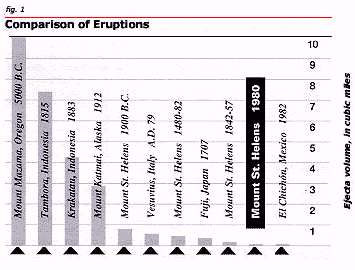Lesson 3: Up in the Air
 |
| Fig 1: The volume of ash ejected during an eruption is one factor in measuring the size of an eruption. Note that the May 18 volume was less than several earlier eruptions of Mount St. Helens and considerably less than eruptions of other volcanoes. |
In less than 10 minutes after the onset of the cataclysmic eruption of Mount St. Helens, a column of tephra, steam, aerosols, and gases reached an altitude of 19 kilometers (12 miles). Although the largest fragments of tephra fell back to the ground close to the volcano, the smallest fragments, ash and dust, were carried eastward by the prevailing winds. Five days after the eruption, monitoring instruments in New England detected ash from Mount St. Helens. Some of the ash eventually circled the globe and the smallest fragments and aerosols remained suspended for years in the stratosphere.
Day Becomes Night
Moving at an average speed of 95 kilometers per hour (60 miles per hour), the ash cloud reached Yakima, Wash., by 9:45 a.m. Pacific Daylight Time and Spokane, Wash., about 2 hours later. In Yakima, a city of 51,000, day became night. Automobile and street lights remained on for the rest of the day as the eruption continued for more than 9 hours. Ash as fine as talcum powder clogged engine air filters and choked people - face masks or handkerchiefs were a necessity for those who ventured out of doors.
Ash blanketed the ground like snow, but snow that would not melt. Residents shoveled and bulldozed ash from streets, sidewalks, and roofs; an estimated 600,000 tons of ash were removed from the city. It took 10 weeks to haul it away!
Volcanic Ash's Deadly Effects
Ash fall, however, is more than an inconvenience. It can be lethal to plants, wildlife, and humans. Swirling particles of ash in the atmosphere generated lightning, which in turn ignited hundreds of forest fires near the volcano. Autopsies revealed that most of the human deaths in the blast area resulted from asphyxiation, from inhaling hot volcanic ash during the first few minutes of the eruption.
As the ash settled to the ground, it also took its toll. Eastern Washington became known as the "ash belt" where many farm crops were destroyed in areas of thick accumulation. Volcanic ash can also affect aircraft operations. Jet engines are susceptible to damage: the volcanic ash coats and melts turbine blades, often causing the engines to stall.
Impact on Climate
Volcanic eruptions can also affect climate and weather patterns. Mount St. Helens' 1980 eruptions did not have a significant effect on global climate, but the 1982 eruption of El Chicḥn in Mexico, for example, had measurable effects. El Chicḥn's magma was much richer in sulfur than Mount St. Helens'. As a result, the Mexican volcano produced sulfuric acid aerosols (a fine mist of particles) that formed a layer of haze in the stratosphere. This haze, which can remain in the atmosphere for years, reflects the sun's radiation and reduces surface temperatures. For example, more than a year after the April 1815 eruption of Indonesia's Tambora volcano, its effects were felt. In the northeastern United States, 1816 was so cold that snow fell in some New England States in June and July. It was known in New England as the "year without a summer."
How Much Ash Fell?
In comparison to other historic eruptions, the volume of ash fall from the 1980 eruption of Mount St. Helens was relatively small (fig. 1). The eruption of Tambora ejected 150 times more ash than Mount St. Helens in 1980. And ash ejected by Mount Mazama (now Crater Lake), located about 125 kilometers (200 miles) south of Mount St. Helens, was even greater than Tambora. The 1980 eruption of Mount St. Helens was only an inkling of the destructive potential of a volcanic eruption.
|